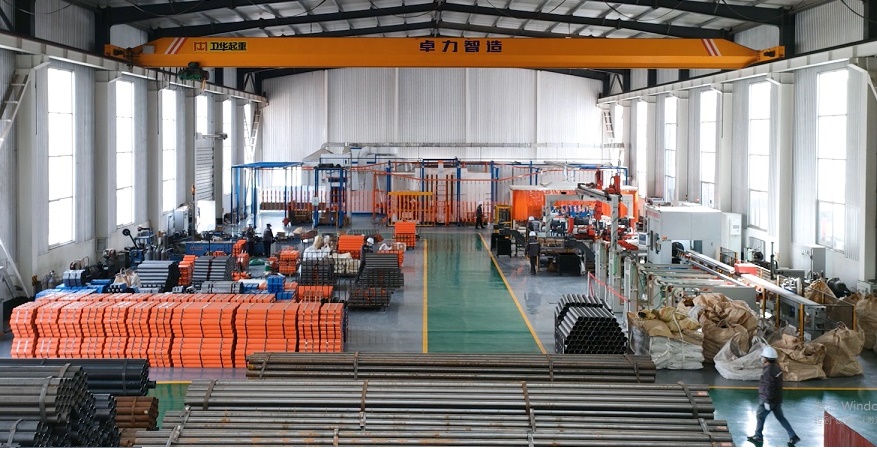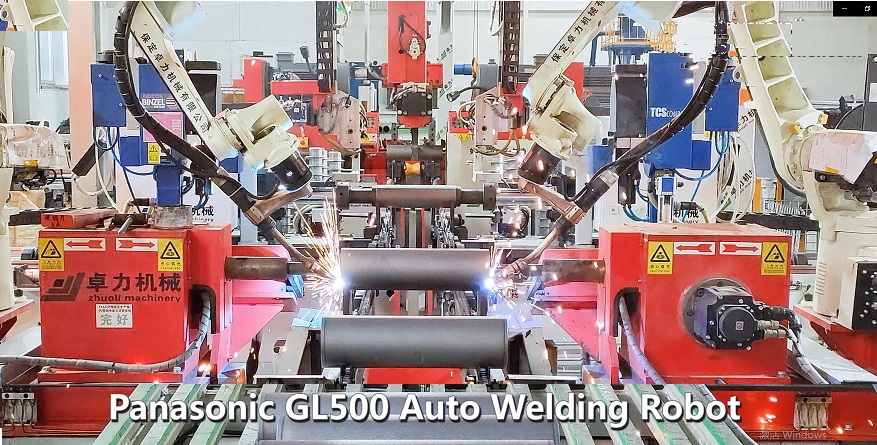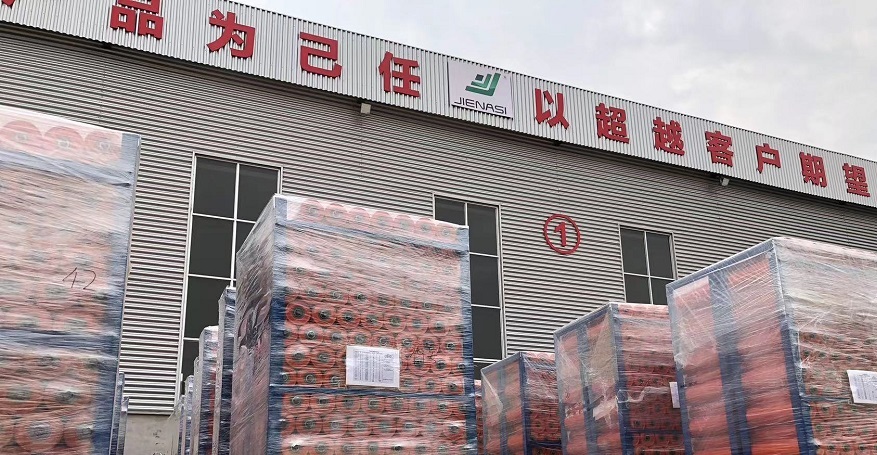1. The verticality error between the installation position of the load-bearing conveyor idler group and the center line of the conveyor is relatively large, which causes the conveyor belt to deviate in one direction in the load-bearing section. When the conveyor belt runs forward, it gives the conveyor idler a forward traction force Fq. This traction force is decomposed into a component force Fz that makes the conveyor idler roll rotate and a lateral component force Fc. This lateral force causes the conveyor idler to move axially. The fixed conveyor idler of the bracket cannot move axially, and it will inevitably generate a reaction force Fy to the conveyor belt, which makes the conveyor belt move to the other side, resulting in misalignment.
It is not difficult to understand the reason for the misalignment of the conveyor belt after clarifying the force situation when the load-bearing conveyor idler group is installed and deflected, and the adjustment method is also clear.
The first method is to process the mounting holes on both sides of the conveyor idler set with long holes for adjustment during manufacture. The specific method is which side of the belt is biased, which side of the conveyor idler group moves forward in the direction of belt advancement, or the other side moves backward.
The second method is to install the self-aligning conveyor idler group. There are many types of self-aligning conveyor idler group, such as the intermediate shaft type, four-link type, vertical conveyor idler type, etc. The principle is to use the blocking or the rotating block of the conveyor idler in the horizontal plane. Or generate a lateral thrust to make the belt automatically centripetal to achieve the purpose of adjusting the belt misalignment, and its stress situation is the same as that of the load bearing conveyor idler set. Generally, it is more reasonable to use this method when the total length of the belt conveyor is short or when the belt conveyor runs in both directions, because the shorter belt conveyor is easier to deviate and is not easy to adjust. It is best not to use this method for long belt conveyors, because the use of self-aligning conveyor idlers will have a certain impact on the service life of the conveyor belt.
2. The axis of the head drive pulley or the tail tail pulley is not perpendicular to the center line of the conveyor, causing the conveyor belt to deviate at the head pulley or the tail pulley. When the conveyor pulley is deflected, the tightness of the conveyor belt on both sides of the conveyor pulley is inconsistent, and the traction force Fq received along the width direction is also inconsistent, showing an increasing or decreasing trend, which will add a moving force Fy in the decreasing direction to the conveyor belt. , causing the conveyor belt to deviate to the loose side, which is the so-called "running loose but not tight". The adjustment method is: for the drive pulley, if the conveyor belt deviates to the right side of the pulley, the bearing seat on the right side should move forward, and the conveyor belt deviates to the left side of the pulley, then the bearing seat on the left side should move forward correspondingly, the left bearing seat or the right bearing seat can be moved backward. The adjustment method of the tail pulley is just opposite to that of the drive pulley. After repeated adjustments until the conveyor belt is adjusted to an pulley position. It is best to install its position accurately before adjusting the driving or tail pulley.
3. The diameter of the outer surface of the pulley is different due to processing errors, sticky materials or uneven wear, and the conveyor belt will deviate to the side with a larger diameter. That is the so-called "run to big but not small".
4. The wrong position of the blanking at the reloading point causes the misalignment of the conveyor belt. The material's blanking position at the reloading point has a great impact on the misalignment of the conveyor belt, especially in the projection of the upper conveyor and this conveyor on the horizontal plane. The effect is greater when vertical. Generally, the relative height of the upper and lower belt conveyors at the transfer point should be considered. The lower the relative height, the greater the horizontal velocity component of the material, and the greater the lateral impact force Fc on the lower belt, and it is also difficult for the material to be centered. The material on the cross-section of the conveyor belt is deflected, and the horizontal component force Fy of the impact force Fc eventually causes the belt to deviate. If the material deviates to the right, the belt deviates to the left, and vice versa.
A Step-by-Step Guide to Selecting the Right Conveyor Idlers 2023
10 basic factors to consider when choosing a suitable conveyor idler
Only one table can help you easily choose the right conveyor idler set (belt width from500~2400mm)
3 key parts that most affect the operating life of conveyor idlers
For the misalignment in this case, the relative height of the two conveyors should be increased as much as possible during the design process. The form and size of the upper and lower funnels, guide troughs and other parts of the belt conveyor limited by space should be carefully considered. Generally, the width of the guide groove should be about three-fifths of the belt width, which is more appropriate. In order to reduce or avoid the misalignment of the belt, the baffle plate can be added to block the material, and the falling direction and position of the material can be changed.
5. The problem of the conveyor belt itself, such as the conveyor belt has been used for a long time, aging deformation, edge wear, or the center of the remade joint after the conveyor belt is damaged, these will cause the tension on both sides of the conveyor belt to be inconsistent. Partial. In this case, the entire length of the conveyor belt will deviate to one side, and the maximum misalignment is at the joint that is not right. The only way to deal with it is to remake the glue joint with the wrong center, and replace it if the conveyor belt is aging and deformed.
6. The tensioning device of the conveyor makes the tension of the conveyor belt insufficient, and the conveyor belt will not deviate when there is no load or a small amount of load. When the load is slightly larger, it will deviate. The tensioning device is an effective device to ensure that the conveyor belt always maintains sufficient tension. If the tension is not enough, the stability of the conveyor belt will be poor. The counterweight can be added to the belt conveyor using the hammer tensioning device, but it should not be added too much, so as not to make the belt bear unnecessary excessive tension and reduce the service life of the belt. For belt conveyors that use screw tension or hydraulic tension, the tension stroke can be adjusted to increase the tension. However, sometimes the tensioning stroke is not enough, and the belt is permanently deformed. At this time, a section of the belt can be cut off and glued splicing again.
7. For belt conveyors designed with concave sections, if the radius of curvature of the concave section is too small, if there is no material on the belt during startup, the belt will bounce up in the concave section interval, and it will also move when it encounters strong winds. The belt is blown off, so it is better to add a pressure pulley at the concave section of the belt conveyor to avoid the belt from bouncing or being blown off by the wind. The lower pass-through conveyor belt of the bucket wheel stacker-reclaimer will have a large concave section when the tail truck is stacking, where misalignment is most likely to occur. For example, if the frame of the conveyor on the lower floor sinks, it will aggravate the vacated range of the conveyor belt, and it is easy to deviate. Therefore, a larger radius of curvature of the concave segment should be used as much as possible in the design stage to avoid such situations.
8. The adjustment of the misalignment of the two-way running belt conveyor. The adjustment of the belt misalignment of the two-way running belt conveyor is relatively more difficult than the adjustment of the misalignment of the one-way belt conveyor. In the specific adjustment, one direction should be adjusted first, and then the other should be adjusted. direction. When adjusting, carefully observe the relationship between the direction of belt movement and the trend of misalignment, and adjust them one by one. The focus should be on the adjustment of the driving pulley and the tail pulley, followed by the adjustment of the conveyor conveyor idlers and the adjustment of the material drop point. At the same time, it should be noted that when the belt is vulcanized, the force in the length direction of the belt section should be uniform, and the force on both sides should be as equal as possible.



Contact: Export Department
Phone: +86 15097752737
Tel: +86 0312 5308005
Company: Baoding Zhuoli Machinery Co.,Ltd
Add: 3934 Tower3,Weilaishi building,Xiongan New Area.Baoding city,China